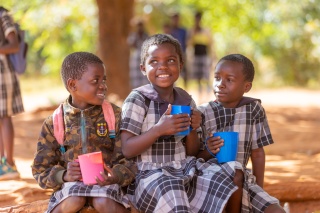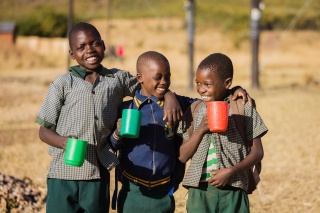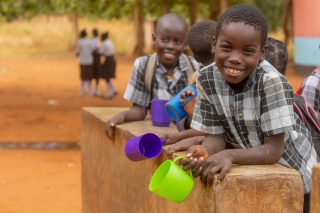
Feeding Zambia’s future
Following 10 years of Mary’s Meals school feeding in Zambia, we’re now serving daily school meals to more than 400,000 learners.
“I believe when a child is fed, he [or she] is able to come to school and concentrate. A hungry child will never concentrate at school,” says Headmaster Peter Chanda of Kapara Primary School, in Eastern Province, Zambia.
Since Mary’s Meals’ school feeding programme came to the school in 2014, enrolment has risen from 500 pupils to more than 1,400 today, and teaching is now carried out in three shifts daily to manage the demand.
Kapara was one of the first 25 schools to serve Mary’s Meals in Zambia a decade ago, serving around 18,000 students (or learners as they are called in Zambia) every school day. Exam results have also improved dramatically at Kapara. Grade 9 students achieved a pass rate of more than 80% this year, compared to a rate of 50% ten years ago.

Expanding school feeding in Zambia
Panji Kajani is the Mary’s Meals Country Director for Zambia. He has steered the school feeding programme from 2014 to its current position, now serving daily school meals to more than 400,000 learners in 11 districts of Eastern Province, where Mary’s Meals is by far the largest school feeding partner to the government.
Work is underway to expand the school feeding programme further to reach even more children living in largely rural, often hard to reach areas and facing hunger and food insecurity.
Panji explains: “Zambia has experienced challenging economic conditions over the years and continues to rely heavily on smallholders and subsistence farmers for the majority of its food supply. This is subject to variable and often extreme weather conditions, and Eastern Province has suffered severe drought for the past three years, from which it will take more than one season of ‘normal’ rain to recover.”
“As Mary’s Meals celebrates 10 years of working here in Zambia, the need for our work is greater than ever. In recent months, we have expanded to two new districts and added more than 60,000 children to our programme. Over the coming months, thanks to our generous supporters, we are expanding our reach even further, with the ambition to reach more than 500,000 children in Zambia by early 2025.”

Serving the most vulnerable children in remote areas
Despite Zambia’s economic growth of the past decade, more than two-thirds of the population live in poverty. The World Food Programme estimates that 3.3 million people have insufficient food consumption, and 34.6% of children under five have stunted growth. In rural areas like Eastern Province, the challenges are evident.
Eastern Province is a large area bordering Malawi to the east and Mozambique to the south. Lusaka, Zambia’s capital, is an eight-hour drive away, half of which is on poor quality, potted roads. In 2022, the population of the region was estimated at just short of 2.5 million people. Chipata, the provincial capital and where Mary’s Meals is based, is the key transport hub between Zambia and Malawi. It’s home to a few larger employers and thousands of micro businesses all hustling for trade, many of which are on bicycles, a relic from the city’s former bicycle factory that used to employ a lot of local people but has long since closed down.
Panji explains the challenges of this region: “Our mission is to serve the most vulnerable children and go where the need is greatest. In this region, it means taking our programme to remote areas and overcoming the challenges of difficult access for food deliveries and the weekly monitoring of school feeding. It gets especially difficult in the rainy season.”
“We know that where we feed, the schools attract learners from great distances, with very young children often walking in the dark on unlit roads and tracks for an hour or more to get to school. That’s why, with our latest expansion plans, we are first working to take our programme to more schools in the districts where we already work to reduce the ‘magnet effect’ and the distances children have to travel to access nutritious school meals.”

Reducing poverty through engaging the local community
A key pillar of the way Mary’s Meals works is community involvement. The community takes charge of the everyday running of the programme in collaboration with the school. They organise the volunteer cooking rota, the storage and security of the food, cooking the right amount of food daily, and keeping appropriate records.
Peggy, a volunteer cook at Nyakutwa Primary School, explains why this model is so important: “I did some farming last season and, as we speak, I only have five bags of maize left to last us the rest of the year. These bags will last a bit longer because my children have porridge at school. When a child eats at school, they only have one other meal at home, making the little food that we have last longer. We have been saved by this porridge.”
Rogers Njovu lives in Chiyewe close to Taonga Primary School where some of the first Mary’s Meals were served to children in 2014. Rogers heads a family of eight. Three of his children attend the local school. The family survives on farming soybeans, maize, and tobacco, and they supplement their income by making bricks.
Rogers explains why the school feeding programme is vital to rural families: “We have had terrible rain patterns over the past few years which have made things very hard for families like ours. I can see the children rush to school because they know there is food there, and I am so grateful to Mary’s Meals for this. This programme has helped a lot of households locally like ours. The children can concentrate, and they become educated. I know of local young people who have gone to secondary school and university because of the Mary’s Meals school feeding programme. It is helping us to reduce poverty.”

Partnering with the Zambian government
The government too recognises the role Mary’s Meals plays in the lives of so many children in Eastern Province. We are by far its largest school feeding partner in the region.
Malalu Mulundika is the Government of Zambia’s Minister for School Health and Nutrition. She says: “Mary's Meals and the Ministry of Education have a very good relationship and fantastic partnership. [In places of education] where we introduce school feeding, dropout rates reduce and enrolment levels increase. Mary's Meals is predominantly [serving children] in Eastern Province, and Eastern Province for a long time has been doing very well in terms of examination results. So, we are very, very grateful and happy with the support that we've been getting through the Mary's Meals programme.
For Mary’s Meals Zambia, this support will continue for as long as it is needed, thanks to the generosity of our supporters and donors from around the world.
Felicity Read is our Director of Communications.
It costs just £19.15, €22, $25.20 USD or $31.70 CAD to provide a child with school meals for an entire school year. Read an article about how we’ve been feeding Zambia’s future for the last 10 years and learn more about how the promise of a daily enables the children we serve in Zambia to receive an education.
